Article and all photos by Joe Mock, BaseballParks.com
All rights reserved
There are only a handful of baseball parks that you could accurately describe as having a design unlike any other … and more often than not, the design in question is unique in negative ways rather than positive. The new flagship ballpark of the Class AA Texas League, Dr Pepper/Seven Up Ballpark in Frisco, is both wonderful and unique, and that’s a rare combination indeed. No doubt about it, the Frisco RoughRiders have one of the premier parks in all of the Minors. That’s why it was named “Best New Ballpark for 2003” by BASEBALLPARKS.COM.
 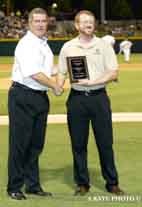 |
| The date was April 3, 2003. Here’s the very first pitch of the first game played in this fantastic new facility. Five months later, BASEBALLPARKS.COM’s Joe Mock presents RoughRiders President Mike McCall with a plaque signifying that the park had been named Best New Ballpark of 2003. PHOTO ON RIGHT BY A. KAYE. USED BY PERMISSION. |
The competition for this honor was very intense, because 2003 saw the opening of a number of truly impressive parks in affiliated baseball. Frisco won out over the following facilities: Lake County, Ohio (Class A); Rome, Georgia (also A); Jacksonville, Florida (Class AA, like Frisco); Albuquerque, New Mexico (Class AAA) and even a new facility in the Majors! Yes, Dr Pepper/Seven Up Ballpark impressed me far more than Great American Ballpark in Cincinnati. Let’s look at the various elements of Frisco’s park that make it so impressive.
The Design
Thanks to the RoughRiders’ front office (particularly their wonderful VP of Communications, Shellie Johnson), I was given several tours of the park while it was being built, so I knew in advance that something special was being constructed here. But the aesthetics of a ballpark are only as good as the original “concept” envisioned by the architects, and this case, the credit for Frisco’s innovative layout goes to the design architect for this project, David M. Schwarz. His vision was to create a setting where the concession stands, restrooms, and luxury suites were in separate buildings at the rear of the main seating bowl. These buildings, which are called “pavilions,” have the look of garden apartments or vacation condos. The food and restrooms are on the ground level, with the luxury boxes on the upper level. Best of all, there is a great deal of space between each pavilion, and walkway “bridges” connect the upper level of each pavilion with the one next door.
And the space between and behind the buildings is anything but wasted. To the contrary, winding paths and beautiful landscaping abound, conveying the feeling of walking in a municipal park — in essence, a “park within a (ball)park.”
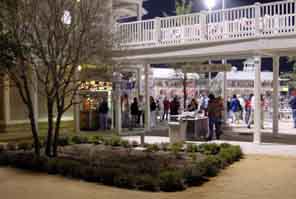 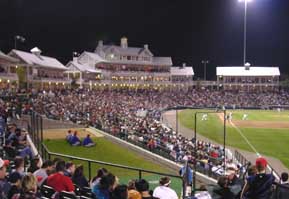 |
| On the left, the “park within a park” look. The landscaping and winding walkways are extremely attractive. On the right, you can see the visitors’ bullpen, surrounded by seats. |
Finding the way to execute Mr. Schwarz’ wonderful concept was the task of HKS, the Dallas-based architects that collaborated with Schwarz on The Ballpark In Arlington. The marriage was a great success for the Rangers’ facility, and it worked beautifully in Frisco, too.
Another feature of the park’s design that has generated a lot of interest nationally is the location of the bullpens. Not content to drop them behind the outfield fence or along the foul lines, these designers took the incredibly bold step of positioning them in the stands. That’s right, the pitchers warm up with fans sitting all around them. I wonder if that makes the hurlers feel a little claustrophobic!
The Preparation
You might think that the actual construction and the materials used would be of little interest. Not so here, as Centex and other contractors carried out the plans from Schwarz and HKS beautifully — and on time! In fact, on the park’s opening night, I received a tap on the shoulder as I was taking photos from the concourse in the outfield. It was Jim Hodnett, the construction super who was in charge of overseeing the building of this facility. He remembered me from giving me tours of the construction site during 2002 — and he also remembered a statement I’d made to him at the time: “No new ballpark is ever completely finished when they start playing games in it.” That night, he challenged me to find an aspect of Frisco’s park that was incomplete. He had me there!
Jim’s impact on this project cannot be overstated. As someone from David Schwarz’s office told me, Jim is “one of the best site supers I’ve ever had the pleasure to work with. He fostered a lot of teamwork, kept up the momentum and the energy level for the trades on the site, made things happen from a design standpoint by not letting so-so work slide by, and clearly was instrumental in getting the park done ahead of time.
 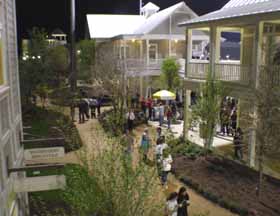 |
| Construction Super Jim Hodnett was very effective in getting the ballpark completed on time. The “residential” look is evident on the right. |
I need to say a word about the building materials used in this stadium. One reason the pavilions look so pretty and “residential” is because their exterior is made with Hardiplank, instead of the usual brick or stone found at other ballparks. As was pointed out to me by Greg Whittemore, HKS’ Project Architect for this ballpark, Hardiplank is not only used on houses and apartments all over Texas, it is also far less expensive than masonry — and every bit as fire-resistant. In other words, this building material not only helped keep the pricetag for the project down, it also helped convey the residential look of the pavilions.
The Experience
When you enter the park through the gates directly behind home plate, the “pavilion” buildings there have been spruced up with a Wild West theme, and it is very attractive. You then arrive at a plaza of sorts, in between three of the pavilions. The night I was there, actors in Western costumes were trading barbs and simulating gun fights. It really is a festive scene.
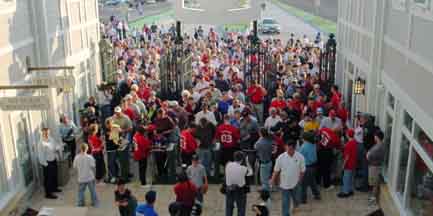 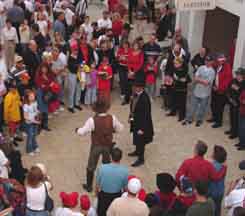 |
| The crowds pour in for the first game at Dr Pepper/Seven Up Ballpark. On the right, “RoughRider” actors entertain fans. |
I mentioned above the wonderful “park in a park” experience of the winding paths and landscaping. These are beautifully done. In fact, the landscaping is the nicest I’ve seen within the confines of a ballpark outside of Florida (to me, Vero Beach and Winter Haven offer the best examples of ballpark landscaping).
And just as everyone enjoys going for a walk in the park, walking around this ballpark is a great joy! One of my favorite aspects of a well-designed baseball facility is the so-called 360-degree concourse. In other words, you can walk all the way around without hitting a point in the outfield where you can’t continue. In Frisco, you can take a stroll completely around the place — and most of the way, you can watch the action on the field from the concourse.
“Fans tell us they enjoy the intimacy of this ballpark and how clean and comfortable it is,” noted RoughRiders President and General Manager Mike McCall. “It’s apparent the minute you walk through the gate…this place is special. It’s magical.”
Another great aspect of the space that is between each pavilion involves air flow. You know it gets unbearably hot during Texas summers. Well, Frisco’s design permits air to circulate better than at almost any ballpark — and that’s a big help. This is one of the key design features of Midland, Texas’ park, which opened in 2002. Round Rock, Texas — which fields a rival team in the Texas League — has a wonderful park, but it is lacking in this area.
While watching the game, you’ll appreciate the high-resolution video screen in left-center field. You’ll be less impressed with the standard scoreboard in right-center. And you may or may not like the long, thin video boards that are actually part of the outfield wall — somewhat like the ones at Staten Island’s park. They have the potential to be gorgeous, and really rev up the crowd. They also have the potential to be annoying, in much the same way as those blindingly bright video elements on the fronts of the upper decks at all the new basketball/hockey arenas.
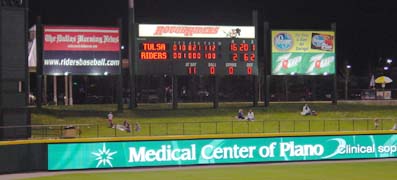 |
| The main scoreboard in right field is not very exciting, but the very-bright video boards in the outfield wall might be a little too exciting. |
The Setting of Dr Pepper/Seven Up Ballpark also deserves mention. Frisco itself is a bedroom community just north of Dallas. The town’s population and commercial appeal are booming. In fact, the second largest mall in the state of Texas is right across the street, giving the baseball fan a number of pre-game eating and shopping options.
The One Bad Aspect of the Park — But Do You Care?
There is one element of Frisco’s park that isn’t up to the standards of the rest of the facility — and it is an aspect that is so inadequate that one baseball official dubbed it “atrocious.” That element is the press box. Perched on the top level of the largest of the pavilions — the one directly behind home plate — it is too cramped and the windows aren’t nearly large enough. To me it is clear that it was more important to the designers that the outside of the pavilion be beautiful and consistent with the other buildings than it was to be a comfortable place for the press to work. But do you, as a fan, really care? I didn’t think so.
I should also add that the ticket prices are high — perhaps the highest in AA baseball. I bet you do care about that. Anyway, the attendance figures suggest that the fans of North Texas don’t find the prices prohibitive. The field itself is, of course, natural grass (Tif Sport Bermudagrass, to be exact), but on Opening Night, it was not in as good a shape as it was later in the season.
But if you think these minor negatives cancel out the good aspects of the park, you would be very wrong. Overall, this is the most impressive Minor League park I’ve visited in years, so it really wasn’t a difficult decision to name it “Best New Ballpark for 2003.”